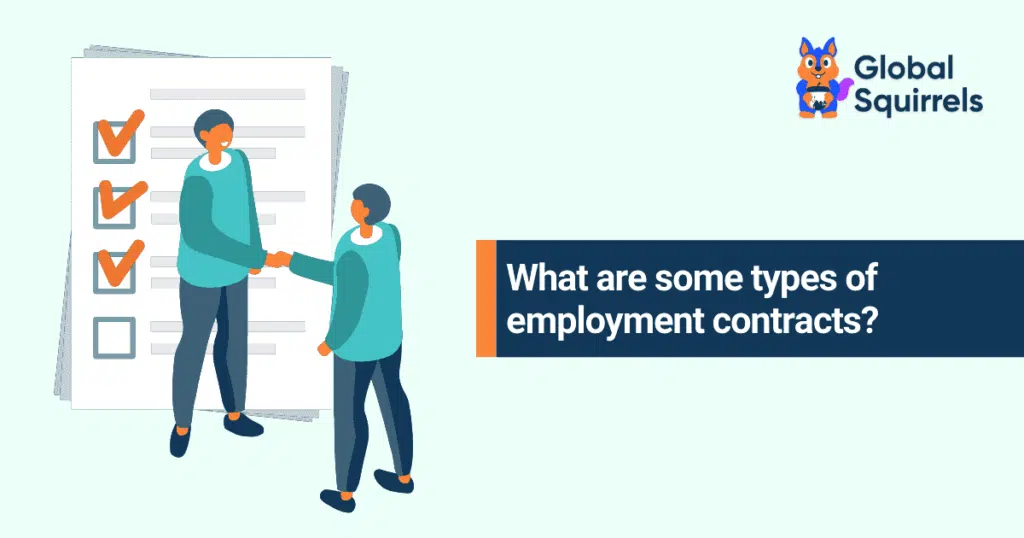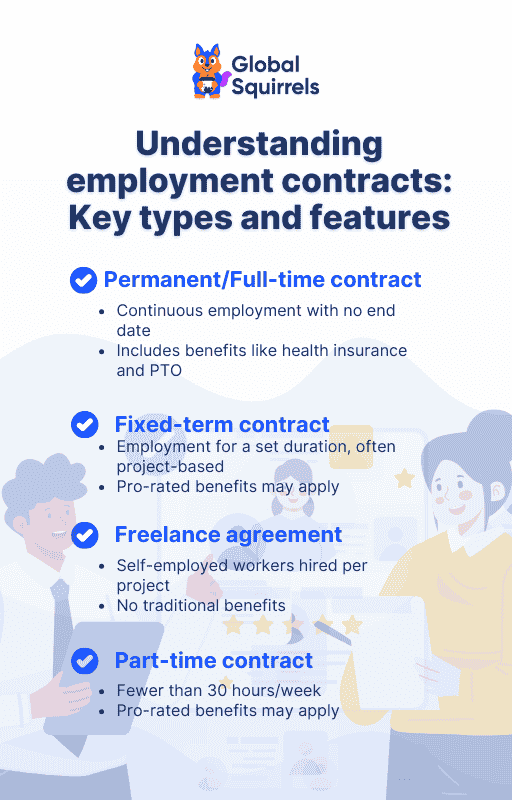What are some types of employment contracts?

In today’s dynamic work environment, understanding the various types of employment contracts is crucial for both employers and employees. An employment contract that is well-defined will establish the framework for a productive and win-win working relationship, as well as the expectations, responsibilities, and terms of employment.
In this blog, we will delve into the world of employment contracts, exploring their benefits, key components, and the different types available. We will discuss everything from full-time contracts and freelance agreements to fixed-term arrangements and at-will employment, clarifying the distinctions and helping you navigate the complexities of an employee contract agreement. We will also address common questions, such as the difference between employment contracts and offer letters, and highlight the risks of hiring without a formal contract. Finally, we will discuss how our platform eases the management of your employees.
So, whether you are an HR professional, a business owner, or an individual seeking clarity on your employment terms, our blog will help you gain a comprehensive understanding of employment contracts.
What are employment contracts?
An employment contract is a legal agreement between the employer and an employee that states the terms & conditions of employment. This document, often referred to as an employee contract agreement, serves to clarify the relationship between the two parties by detailing expectations, rights, and responsibilities. Employment contracts can take various forms, including written agreements, verbal understandings, or even implied terms based on the nature of the work.
Benefits of using employment contracts
Employment contracts are vital in establishing a clear framework for employer-employee relationships, offering multiple benefits that enhance workplace dynamics and organizational stability.
Clarity and structure
An employee contract agreement ensures clarity in roles, responsibilities, and expectations by outlining duties, working hours, compensation, and benefits. By reducing misunderstandings and creating a more organized, professional workplace, you avoid the issues that arise from a lack of organization and professional conduct.
Employee retention and attraction
Offering competitive benefits through employment contracts, such as health insurance and retirement plans, helps attract and retain top talent. A well-defined employee contract agreement increases job satisfaction, reducing turnover and associated costs.
Risk management
Employment contracts minimize risks by clearly defining termination conditions and disciplinary procedures. This helps reduce the chances of disputes and legal claims, ensuring compliance and mutual understanding.
Financial benefits
High retention through strong employee contract agreements leads to reduced hiring costs and improved productivity. A stable workforce that is experienced can help you save on costs and perform better financially.
Enhanced workplace culture
By promoting accountability and clear expectations, employee contracts encourage trust and respect. This security helps drive up the morale of employees, encouraging a positive workplace culture that, in turn, attracts more top of the line talent.
Make hiring effortless with Global Squirrels!
Struggling to manage permanent contracts or freelance agreements? Let Global Squirrels simplify the process for you. From onboarding to compliance, we have got you covered.
Get a demoWhat are the common elements of an employment contract?
An employment contract is an essential legal document that binds the employer and the employee so that both parties are able to know their rights and responsibilities. A well-structured contract not only serves as a written, verbal, or implied document that is mutually beneficial for a working relationship but also as a social norm that helps maintain the standard of conduct.
Identification of parties
The employee contract agreement must include the legal names and addresses of both the employer and the employee, ensuring clarity about the parties involved.
Job title and description
This section outlines the job title, key responsibilities, and performance expectations, forming an essential part of the employee contract to set clear benchmarks.
Employment type
Under the employment contract, the role description clearly states whether the role is full-time, part-time, temporary, or seasonal.
Compensation
Details about salary, bonuses, commissions, and payment frequency (e.g., monthly or bi-weekly) are included in the employee contract agreement, offering financial clarity.
Benefits
The contract highlights benefits such as health insurance, retirement plans, and paid leaves, showcasing the perks that come with employment.
Working hours
It defines working hours, overtime policies, and the expected shift, ensuring that both parties have the same schedule through the employment contract.
Duration of employment
Whether the position is fixed-term or indefinite, the employee contract agreement clarifies the duration and conditions for renewal, if any.
Termination
The contract includes terms on notice periods and valid reasons for termination, providing a structured exit plan under the contractual employee contract.
Non-compete and non-solicitation clauses
These clauses prevent employees from competing with the employer or soliciting clients post-employment, ensuring compliance with the terms of the employee contract agreement.
What are the clauses in the employment contract?
The scope of employment is a common clause that covers the job title, duties, and responsibilities and the probation period for performance evaluation. A termination clause specifies conditions for ending the employee contract agreement, while compensation and benefits detail salary, bonuses, and perks. Confidentiality agreements and restrictive covenants like non-compete clauses are put in place to protect company interests before and after employment. Additionally, dispute resolution processes and governing law provisions ensure clarity in legal matters, while a severability clause maintains the validity of the contractual employee contract even if parts are unenforceable.
What are the different types of contracts?
Understanding the various types of employment contracts is crucial for both employers and employees to establish clear expectations and legal obligations.
Full-time contract
The employee works for a standard number of hours per week (usually 35 to 40 hours) as a full-time employee. Usually, full-time contracts include health insurance, retirement plans, and paid time off benefits.
Freelance contract
A contractual employee contract is a project-based work contract between a freelance contractor and a client. The terms of these contracts specify the work to be done, deadlines, and payment terms, but they generally do not include traditional employment benefits.
Fixed-term contract
This type of contract is fixed for a certain period or until a certain project is completed. When hiring on a project basis, for temporary projects, or for covering for those on leave, fixed-term contracts are the norm. They may include similar benefits to permanent contracts but are limited to the contract’s duration.
At-will agreement
An at-will employment agreement enables the employer or employee to terminate the employment relationship whenever they want and however, they want, as long as it does not violate any employment laws. However, this type of agreement provides flexibility but no job security.
Squirrel fact:98% of employers in the U.S. offer health benefits to full-time employees. |
Are employment contracts and offer letters the same?
Employment contracts and offer letters are distinct documents used in the hiring process, each serving different purposes.
Offer letters
The offer letters are usually brief documents that an employer sends to a candidate to give them a job offer. They provide the basics, such as job title, start date, compensation, and an at-will employment statement, stating that either party can end the employment at any time without cause. Legal binding agreements are not usually offered letters.
Employment contracts
In contrast, employment contracts are comprehensive, legally binding agreements that detail the terms and conditions of employment. It contains specifics on job responsibilities, compensation, benefits, confidentiality agreements, termination conditions, and other key clauses. Enforceable in the court of law and usually used for higher-level positions or when specific terms need to be clearly defined.
What are the risks involved when you hire employees without a contract of employment
In the United States, many employment relationships operate under the “at-will” basis, allowing termination by either party without cause. Employers should be aware of potential risks when hiring employees without formal employment contracts.
- Lack of defined terms: There are no defined terms like job responsibilities, compensation, benefits, and termination procedures. This can cause misunderstandings and disputes between the employer and the employee.
- Legal vulnerabilities: Even in at-will employment, certain terminations can be deemed wrongful if they violate public policy or imply bad faith. For instance, dismissing an employee shortly before their pension vests could be interpreted as acting in bad faith.
- Discrimination claims: Employers who are subject to claims of discrimination or wrongful termination will have a difficult time defending the claims if there is no clear documentation of employment terms and performance expectations.
- Implied contracts: In the absence of a formal agreement, courts may interpret company policies, handbooks, or verbal assurances as creating implied contracts, potentially limiting the employer’s ability to terminate without cause.
Global Squirrels: Explore how our platform helps you manage employees and contracts
Global Squirrels is a staffing and payrolling platform that helps you hire and manage professionals effectively. Our platform handles all HR functions, including providing employment contracts, setting up payroll & timesheets, administrating benefits, managing your employee’s performance & tasks, and complying with all local and international labor & tax laws.
Global Squirrels simplifies employee management for businesses by offering a comprehensive platform tailored to meet the complexities of managing a global workforce. Here is how Global Squirrels helps streamline employee management.
- Country-specific timesheets: Our platform ensures compliance with local labor laws by customizing timesheets to meet the legal requirements of each country. You can set approval frequencies that align with payroll cycles, whether monthly, semi-monthly, or weekly, and use an intuitive interface to monitor and approve timesheets effortlessly.
- Country-specific leave management: Our system seamlessly manages leave policies across different locations and adapts automatically to local legal requirements. You can implement leave policies that align with your business needs while ensuring complete compliance with country-specific regulations.
- Task assignments: Keep remote teams organized and productive by assigning one-time or recurring tasks with clear deadlines. Tasks are integrated directly into the task and performance section, making task tracking visible for both managers and employees.
- Pay increase and termination requests: Simplify payroll and employee management processes through our portal, where you can initiate pay increases or handle terminations with just a few clicks. This ensures timely, accurate adjustments and efficient handling of complex administrative tasks.
You can leverage these features with our Orange and Purple plans.
Orange plan
The Orange plan helps you hire top talent who meet all your business needs. To get started, sign up and select the Orange plan. You will fill out a form with details such as job title, job description, budget, currency, expected start date, educational background, skills, and preferred hiring countries. After submitting your request, you’ll receive curated profiles within 2 to 5 business days. Choose the candidates you want to interview, complete the interviews, and log in to provide feedback. Once you select your candidates, the platform generates offer letters containing job details, benefits, salary, and more. Review and approve the offer letters, and the onboarding process will begin. From this point, our platform will manage all HR functions, including payroll and timesheet setup, benefits administration, task and performance management, and compliance with local and international labor and tax laws.
Purple plan
The Purple plan simplifies onboarding for your current freelancer or pre-sourced candidate. Log in and select the Purple plan. Enter the candidate’s details, including full name, home address, email address, job title, job description, work location, working hours, and any onboarding documents. Once you complete this step, the onboarding process begins. The platform handles all HR functions, ensuring a seamless experience for both you and your candidate.
Are you ready to ease your administrative functions? Request a demo today!

